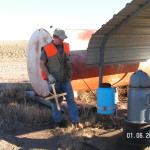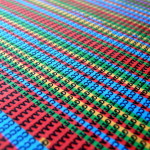Walking up the stone path leading to Our Green Thumb community garden, I peer over the fence and notice that some of the plots look better than others.
“You can tell which ones are student plots,” says Trent Hodges, my guide and a master’s student in International Environmental Policy at the Monterey Institute of International Studies, where the garden is located. He looks at several of the more desolate patches of dirt and shrugs.
Unlike those run by community members, the student plots are suffering from a mid-semester slump as the excitement from earlier in the year meets papers and midterms. Still, some are creatively decorated, and the community plots feature lush leafy greens like kale and butterhead lettuce.

Some plots at the garden are marked with creative decorations. This plot features some leafy greens.
Trent pulls off some arugula and hands it to me. “Sometimes it can be kind of spicy,” he says.
It is. But I’m not here for the plants. Nerd that I am, I came to see the garden’s other attractions: a rainwater catchment system, a proof-of-principle aquaponics farm and—though I didn’t know it when I got there—the garden’s piles of compost.
Through a mix of these projects and community outreach, the students that run the garden are hoping to practice and preach sustainable agriculture—something that is now more necessary given that the year from Oct. 1 to Sept. 30 was the state’s third driest on record in terms of rainfall, according to the California Department of Water Resources. Water saving measures like rainwater catchment and aquaponics can help alleviate the stresses on local water supplies.
The catchment system is the brainchild of the former director of facilities at the Monterey Institute, but the garden put up $800 from its own budget to fund it. The 3,000 gallon tank now sits in the southeast corner of the garden, fed by pipes that catch rain on the roof. Trent leads me around to the back of the tank to point out the path that water follows.
The tank itself feeds a snaking drip sprinkler system that branches like a tree fallen on its side. It serves all the plots in the garden, but uses no pumps. Gravity alone feeds the plants, as the garden sits on a mild grade.
It’s illogical to rely on rainwater during a drought. But the system is a long-term investment that will reduce the stress on the potable water supply when the rain begins to fall.
“By using the rainwater catchment system, we are alleviating the problems associated with drought in California and putting less stress on the Carmel River to feed our garden,” Trent says.
The colorfully decorated catchment tank catches the eye, but the aquaponics farm is hidden discreetly near the back of the garden in a greenhouse. The current system is a small prototype of much bigger commercial farms.
Aquaponics operates as a nearly closed loop of fish, plants and bacteria that requires only sunlight, oxygen, fish food and a small amount of electricity as inputs.
The first step is to feed the fish. They eat their food and pollute the water with their waste. A pump lifts that dirty water to a separate tank, where bacteria break down the waste, cleaning the water and releasing nutrients for the plants. Then the plants, with their roots growing into a rock bed immersed in water, use up the nutrients and the water returns to the fish tank, where the cycle starts again.
Trent provides the simple explanation: “The fish poop basically adds all the nutrients to the water for the plants.”
Aquaponics is a way to farm both vegetables and fish efficiently, and it is also a good strategy during a drought. Growing plants with aquaponics requires no soil. This is important, Trent says, because soil soaks up lots of water. Plants in soil need double the amount of water to thrive.

The garden’s aquaponics system sits in a greenhouse. This picture shows the tank in which bacteria munches on fish waste to create nutrient-rich water for the plants below.
Sunday afternoons are usually the busiest time at Our Green Thumb. Members will often host workshops explaining catchment or the aquaponics farm, highlighting their impacts on sustainability.
Earlier, Trent tells me what the garden does best. “Lots of compost,” he says. He shows me where community members drop off their compostable trash and the instructions for what can and can’t be composted. They even have a separate worm composting station at the back of the garden, near the aquaponics farm.
I ask if there is anything the worms won’t compost. Citrus, Trent says. The acid isn’t good for them.
But how do you make sure no one lets an orange slip in?
“Sometimes you’ve got to get your hands dirty,” he says.









Comments are closed.